

Strategiesthatdifferentiateinstruction4.12. Supporting Access in Science. Closing the gap: test and learn - executive summary (Winter 2016) Improving learning in mathematics. AEM: Differentiated Instruction and Implications for UDL Implementation. Author(s) Tracey Hall, Ge Vue, Nicole Strangman, and Anne Meyer Publisher National Center on Accessing the General Curriculum (NCAC) Please note: This article was updated on 10/6/2014.
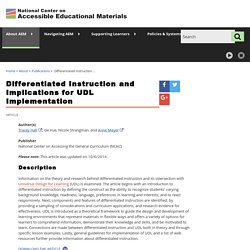
Description. SAGE Journals: Your gateway to world-class journal research. SAGE Journals: Your gateway to world-class journal research. Improving Students’ Learning With Effective Learning Techniques: Promising Directions From Cognitive and Educational Psychology – Association for Psychological Science.
Read the Full Text (PDF, HTML) Some students seem to breeze through their school years, whereas others struggle, putting them at risk for getting lost in our educational system and not reaching their full potential.
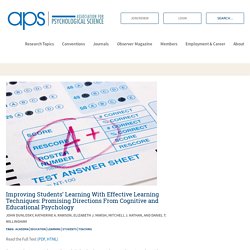
Parents and teachers want to help students succeed, but there is little guidance on which learning techniques are the most effective for improving educational outcomes. This leads students to implement studying strategies that are often ineffective, resulting in minimal gains in performance. What then are the best strategies to help struggling students learn? Fortunately for students, parents, and teachers, psychological scientists have developed and evaluated the effectiveness of a wide range of learning techniques meant to enhance academic performance. The authors describe each learning technique in detail and discuss the conditions under which each technique is most successful.
Which learning techniques made the grade? About the Authors (PDF, HTML) By Henry L. DweckEducationWeek. Carol Dweck - A Study on Praise and Mindsets. Carol Dweck: "The Growth Mindset". Professor Carol Dweck 'Teaching a growth mindset' at Young Minds 2013. Carol Dweck: Mindset interview. Carol Dweck: Mindset interview. Wayfaring Path - Home. 6 tips and tools for social learning on FutureLearn. Blog Posted by David Thair04 Sep 2014 FutureLearn’s Social Lead, David Thair, shares his top six tips for getting the most out of our social learning features.
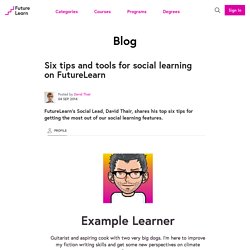
At FutureLearn we believe in the power of learning through conversation, and we have developed our learning platform to enable this. Instead of having separate forums or discussion boards, you can leave comments and have a conversation on almost every step of a course – just press this button: But with thousands of learners making comments, making sense of them all might seem overwhelming to begin with. 1. If you haven’t already, you should add some information to your FutureLearn profile – just like our example learner above. You should also add a profile picture. By default, your FutureLearn profile can only be seen by other learners who are logged in. 2.
When you use FutureLearn for the first time it can be tempting to try to read all of the comments on every step of your course. 3. 4. 5. 6. This is the most important tip! Task Maths. Social media tips and tools. FutureLearn is a social learning environment at its heart.
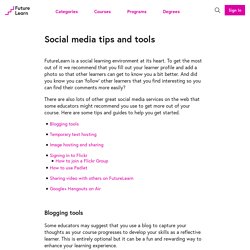
To get the most out of it we recommend that you fill out your learner profile and add a photo so that other learners can get to know you a bit better. And did you know you can ‘follow’ other learners that you find interesting so you can find their comments more easily? There are also lots of other great social media services on the web that some educators might recommend you use to get more out of your course. Here are some tips and guides to help you get started. Blogging toolsTemporary text hostingImage hosting and sharingSharing video with others on FutureLearnGoogle+ Hangouts on Air Blogging tools.
Thinkerstoolbox - Thinkers Keys. Bowland Maths: Assessment Tasks. Scientific Vocabulary. Enriching School Science for the Gifted Learner. Steps to Success in Mathematics: Securing Progress for All Children. DfLV2 Q and A - Episode 1. Bowland Maths Case Studies. Putting differentiation into practice in secondary science lessons. The Use of Velcro in Special Needs Science Lessons. Mathematical challenges for able pupils in Key Stages One and Two. This book of challenges for more able students from the National Numeracy Strategy contains puzzles and problems.

These are accessible to a wide range of students. There are three parts covering Years One and Two, Years Three and Four, and Years Five and Six. The problems are intended to challenge students and extend their thinking. Whilst some of them may be solved fairly quickly, others will need perseverance and may extend beyond a single lesson. Students may need to draw on a range of skills to solve the problems. Many of the problems can be extended by asking ‘What if ....?’. The introduction deals with aspects of classroom organisation, fitting the problems and puzzles into the termly planning, and the three part lesson. Learning objectives appropriate to each problem are indicated so relevant problems can be integrated into the main teaching programme. Working Scientifically in the Primary Classroom. Catering for Dyslexia - how others benefit.
Equipment Flashcards. Recognising hinge-point questions. Concept Cartoons Research - Millgate House EducationMillgate House Education. Concept Cartoons were developed by Brenda Keogh and Stuart Naylor in 1991 as a strategy to elicit learners’ ideas, challenge their ideas and provide pointers for how those ideas might be developed.

Downloads - UYSEG. The documents in this section are provided free of charge to the school science teaching community.
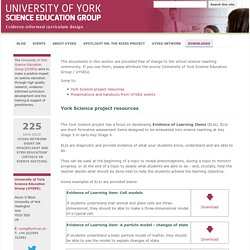
If you use them, please attribute the source (University of York Science Education Group / UYSEG). Plickers. STEM. A level science resource packages. Secondary mathematics resource packages. Differentiation. Questioning STEM bookmark. SOLO Taxonomy. SOLO Taxonomy (structure of observed learning outcomes) provides a simple, reliable and robust model for three levels of understanding – surface deep and conceptual (Biggs and Collis 1982).
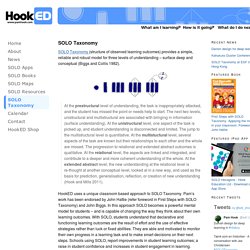
At the prestructural level of understanding, the task is inappropriately attacked, and the student has missed the point or needs help to start. The next two levels, unistructural and multistructural are associated with bringing in information (surface understanding). At the unistructural level, one aspect of the task is picked up, and student understanding is disconnected and limited. The jump to the multistructural level is quantitative. At the multistuctural level, several aspects of the task are known but their relationships to each other and the whole are missed. HookED uses a unique classroom based approach to SOLO Taxonomy.
Revised Bloom’s Taxonomy – CELT. Jump to the Bloom's Revised Taxonomy Model Go to the Flash version of the Bloom's Revised Taxonomy Model Download the PDF Version A statement of a learning objective contains a verb (an action) and an object (usually a noun).
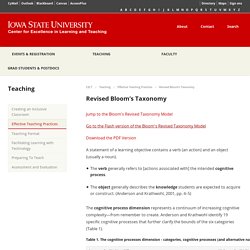
The verb generally refers to [actions associated with] the intended cognitive process. The Educational Theory of Lev Vygotsky: an analysis. What Is Flow? The Psychology Behind This State of Mind. What exactly is flow?

Imagine for a moment that you are running a race. Your attention is focused on the movements of your body, the power of your muscles, the force of your lungs, and the feel of the street beneath your feet. You are living in the moment, utterly absorbed in the present activity. Time seems to fall away. You are tired, but you barely notice. According to positive psychologist Mihály Csíkszentmihályi, what you are experiencing in that moment is known as flow, a state of complete immersion in an activity.
He describes the mental state of flow as "being completely involved in an activity for its own sake. Professional Learning & Community for Educators.